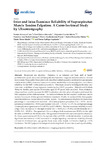Inter-and Intra-Examiner Reliability of Supraspinatus Muscle Tendon Palpation: A Cross-Sectional Study by Ultrasonography

Ver/Abrir
Use este enlace para citar
http://hdl.handle.net/2183/25184Colecciones
- Investigación (FIC) [1656]
Metadatos
Mostrar el registro completo del ítemTítulo
Inter-and Intra-Examiner Reliability of Supraspinatus Muscle Tendon Palpation: A Cross-Sectional Study by UltrasonographyAutor(es)
Fecha
2020-02-18Cita bibliográfica
Naranjo-Cinto, F.; Falcon-Machado, G.; Garrido-Marin, A.; Senin-Camargo, F.J.; Jacome-Pumar, M.A.; Fernandez-Matias, R.; Pecos-Martin, D.; Gallego-Izquierdo, T. Inter-and Intra-Examiner Reliability of Supraspinatus Muscle Tendon Palpation: A Cross-Sectional Study by Ultrasonography. Medicina 2020, 56, 83. https://doi.org/10.3390/medicina56020083
Resumen
[Abstract] Background and objectives: Palpation is an inherent and basic skill of health professionals—particularly manual therapists who base their diagnosis and treatment in a clinical environment. Many authors have previously described multiple palpation positions for supraspinatus muscle tendon (SMT); however, there are no current studies that evaluate palpation concordance reliability for the SMT in this particular position. This study aimed to investigate the intra- and inter-rater reliabilities of supraspinatus muscle tendon (SMT) palpation. Materials and Methods: Thirty-six healthy participants (14 females; aged 22–35 years) were recruited. Musculoskeletal ultrasound was used to measure the SMT localization after two physiotherapists performed the SMT palpation at two different times. The distance between the two marked points was used to analyze the analysis of true agreement between examiners. Finally, we analyzed if the demographic variables influenced the palpation procedure. Results: The intra-examiner reliability showed a high percentage of concordance for examiner 1 (E.1) (first palpation procedure (P.1) = 91.7%: second palpation procedure (P.2) = 95.8%) and examiner 2 (E.2) (P.1 = 91.6%; P.2 = 97.2%) and high percentage of inter-palpation agreement for E.1 (87.5%) and E.2 (88.9%). The inter-examiner reliability showed a high total concordance for the right shoulder (E.1 = 94.4%; E.2 = 95.8%) and left shoulder (E.1 = 93.05%; E.2 = 95.05%). The agreement (%) according to both examiners was 93.05% for the right shoulder and 94.4% for the left shoulder. The agreement between both examiners and the ultrasound (% of true agreement) was 92.9% for the right shoulder and 92.8% for the left shoulder. A statistically significant association (p = 0.02) was found for weight regarding concordance reliability; this was not seen for dominant arm, age, gender, body mass index, height, and tendon depth (p > 0.05). Conclusions: The SMT palpation technique showed a high level of concordance and reproducibility.
Palabras clave
Shoulder
Rotator cuff
Ultrasound imaging
Palpation
Reliability
Rotator cuff
Ultrasound imaging
Palpation
Reliability
Versión del editor
Derechos
Atribución 4.0 Internacional
ISSN
1010-660X






